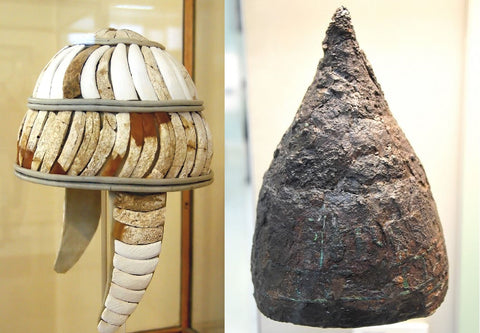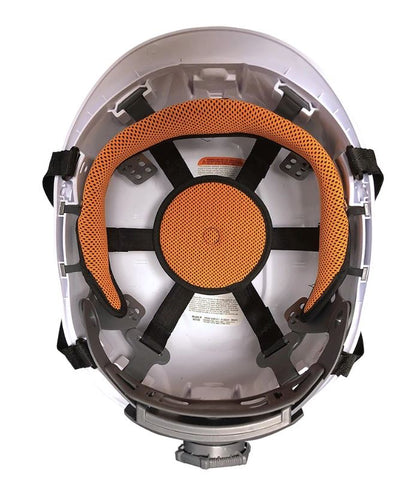History and Evolution of Hard Hats (With a Focus on Klein Tools)
People have probably been protecting the melons on top of their shoulders with helmets since we learned that a good whack on the head could cause permanent irreparable damage or even death. The oldest known helmet is believed to be a Mycenaean helmet made of boar tusk that dates back to 1600 – 1500 BC although there is a conflicting claim that helmets were first used by the Assyrians several hundred years later in 900 BC. To be fair, the Assyrian helmet is probably a little closer to what we recognize as a true helmet being made of leather or bronze and being a single piece. Helmets were primarily used in war but that was not always the case as shown by this 1893 fireman helmet. It’s also said that dock workers of the past also used tar to make improvised hard hats due to the constant head injuries inherent in that line of work. There’s also anecdotal evidence that suggests that writer Franz Kafka invented a hard hat in 1912 for workers while he was addressing worker’s insurance claims, although this is debatable. Definitively, it wasn’t until after the “War to End All Wars” that one of the lucky people to survive it came up with the idea to take advantage of the obvious benefit inherent in protecting your head while doing something dangerous, and better yet, he found a way to consistently make and distribute them which probably led to the success of the hard hat as we know it.
After the war, in 1919, veteran Edward W. Bullard recalled how useful his helmet had been in combat and brought the idea to his father’s mining equipment company and came up with a work helmet for miners and later construction. Originally dubbed the “Hard Boiled Hat” due to the fabrication process, the first hard hats weren’t metal like military helmets, but were made of canvas and shellacked which also made them light enough to wear for an entire work shift. After seeing the obvious benefits in mining, the hard hat was quick to catch on with workmen. It’s not certain how quickly the use of the hard hat spread, but given that it saved lives and prevented injury, most workers probably didn’t need much convincing to wear them, especially since Bullard caught another huge break with the construction of the Golden Gate Bridge up in his hometown of “Frisco.” The lead engineer of the Bridge project asked Bullard to adapt his mining helmet to protect bridge workers and so he did.
It’s unclear when exactly on this timeline that Klein Tools got into the hard hat business. If you know or have old ads and logos, please feel free to share them with us so we can put them up. What is known for sure is that Klein’s earlier logos and early marketing photos show a lineman up on a pole without head protection, but as time went on the safety of hard hats became an industry need, the Klein logo was updated so that the lineman is wearing a hard hat. Most of the catalogs you can find are modern and feature pictures of workers wearing a hard hat. The hard hat has more or less become an identifying feature of Klein’s brand and this is probably as much to do with OSHA regulations as it is workers realizing the value of the headgear.
In all likelihood, Klein’s involvement with hard hats increased as hard hats gained a lot of popularity over the decades and probably more so when hard hats became an OSHA requirement in the early 1970’s. Over this time, Klein not only made hard hats but has been trying to make them better by adding safety features and improving comfort. It certainly makes sense to do that since this piece of PPE was now a requirement, it would probably be best to stand out by making the best hard hat possible and by making hard hats to protect against unique hazards.
There are many different types of job sites and each has its own inherent dangers and needs for safety and comfort. Klein Tools has added many features to hard hats making it easy to use any hard hat from one job site to another. The hard hats made by Klein are considered to be some of the safest and most comfortable hard hats available, and when you look at the features many of the newer models have, you’ll see why. Klein makes hard hats – all under $100 – that get you something as basic as a standard yellow hard hat all the way up to Class C or Class E safety helmets. In each of those categories there are different styles, features and configurations. Each style of helmet is of course tested to the most up to date safety standards ensuring safety on the job and are meant to provide limited protection from small objects hitting the hard hat in the top, front, back, left and right sides of the hard hat and they are not an ANSI/CSSA Type II hard hat, according to Klein’s product literature.
The main difference between Klein’s Class C and the Class E is that the Class E hard hats are designed for linemen, electricians, and telecom tower/windmill technicians. Think class E – electrical. The Class E is made and tested to protect from electrical hazards up to 20,000 volts in addition to the standard protection against impacts that hard hats are designed to protect against. Because they need to protect against electric shock, Class E helmets are not vented. If they were, electricity could probably get through the air holes. Conversely, Class C helmets are designed for general protection in regular jobs like construction, plumbing carpentry, iron workers and many, many more. Think class C – contractor and construction. Class C comes in a non-vented or vented (with closeable vents) for maximum cooling.
Aside from the key differences in what the hard hats protect you from, they are largely similar and both come in visually similar styles and with many of the same features including six-point suspension, open frame design and a rear neck pad with a one hand adjustable knob making it easy to find the right level of comfort. The hard hats also include connections for an optional chin strap. All of Klein’s hard hats, except the standard yellow come with a mount for adding on one of Klein’s compatible hard hat headlamps and some of the helmets come with the lamp included. No strap is needed for the light in either case. The hard hats also include universal accessory slots for easy mounting of hearing protection, visors and more.
Helmets and head gear have been with us for thousands of years, and the last century in particular saw this protection applied to civilian life while doing dangerous work. Since their inception as work PPE, hard hats, thanks to manufacturers like Klein Tools, have gained more features and become safer and more comfortable to wear for long periods. While it may seem that hard hats can’t surpass their current greatness, it will be interesting to see what improvements can be made in the future as nano materials continue to push the boundaries of what’s possible and allow for lighter and more durable protective products to be made. As these safety products improve, we’ll continue to sell the newest, and more importantly, the best tools and safety equipment available.



























Leave a comment